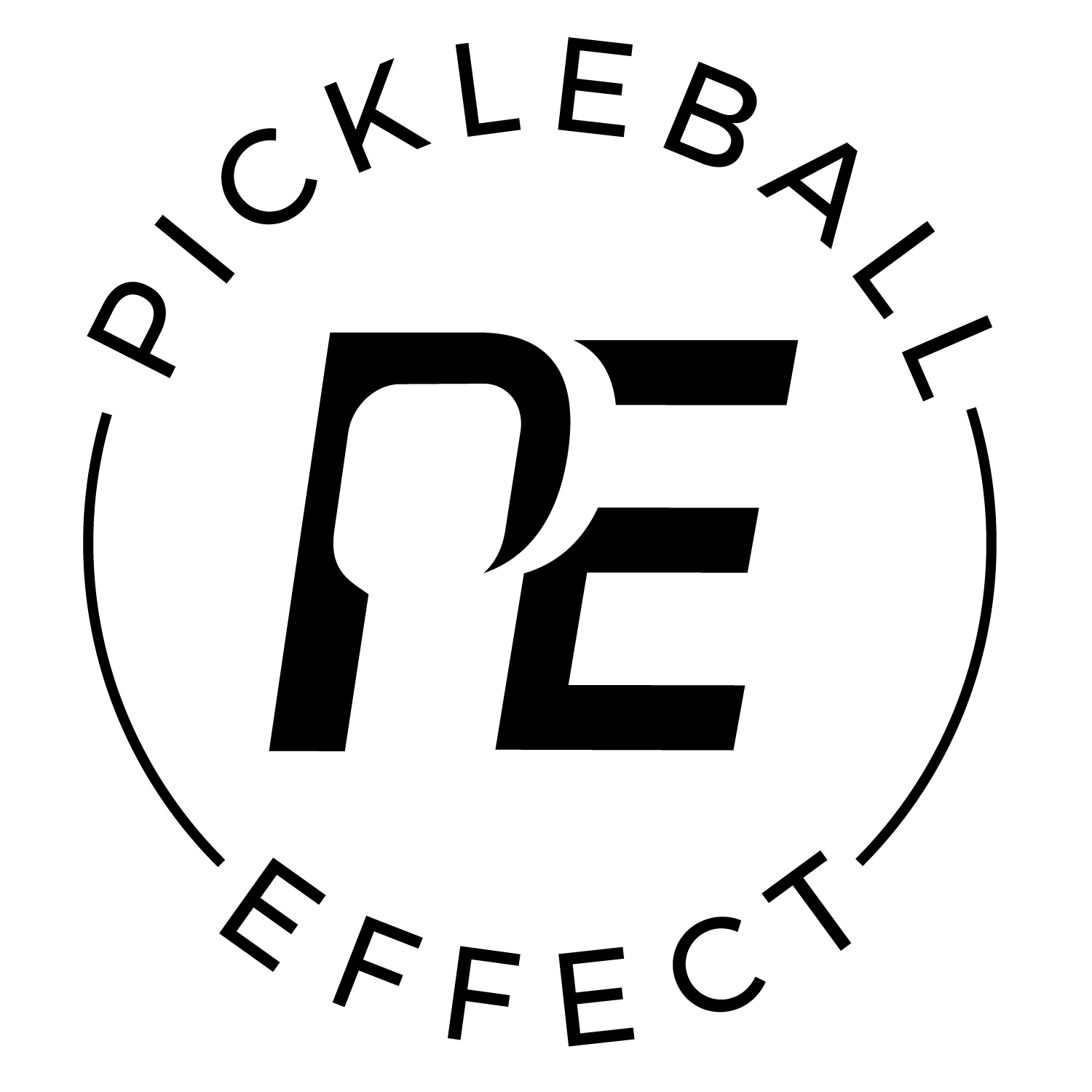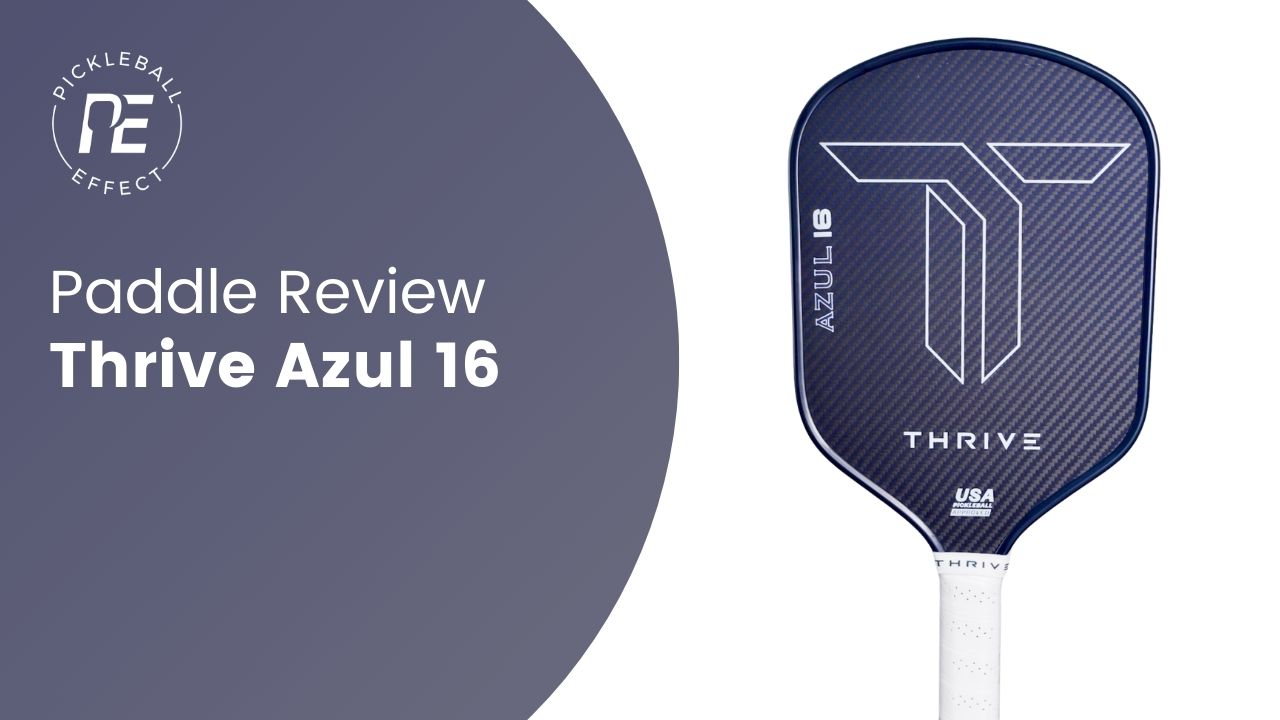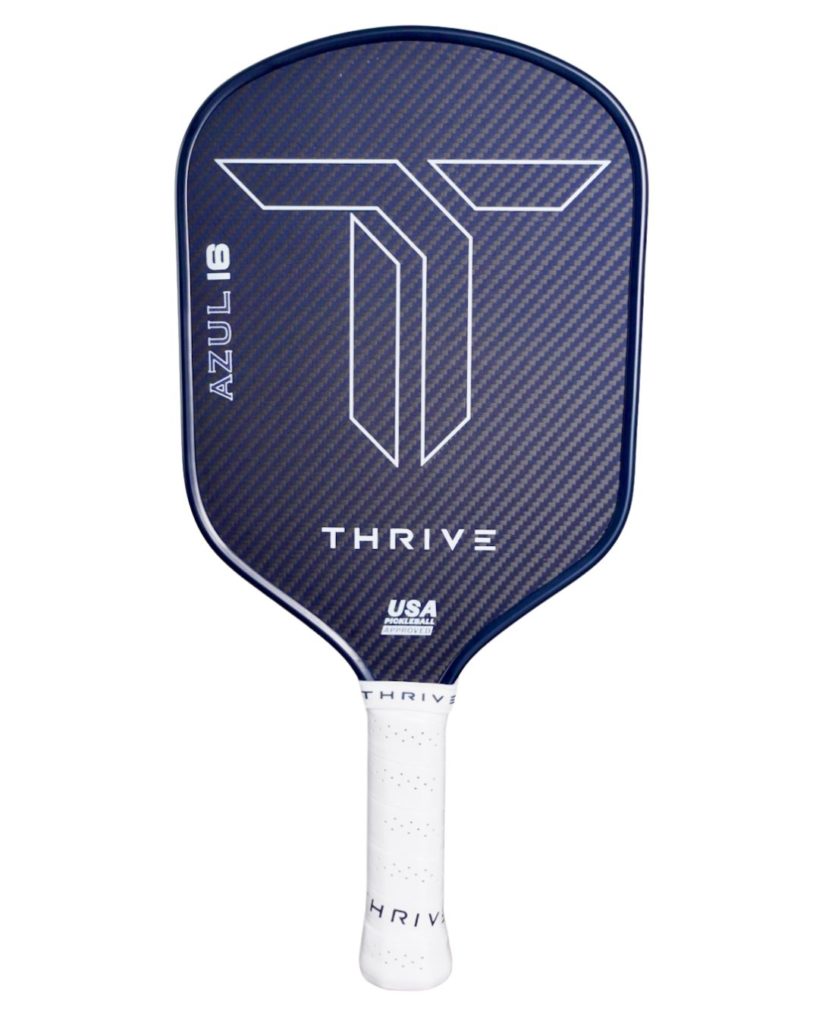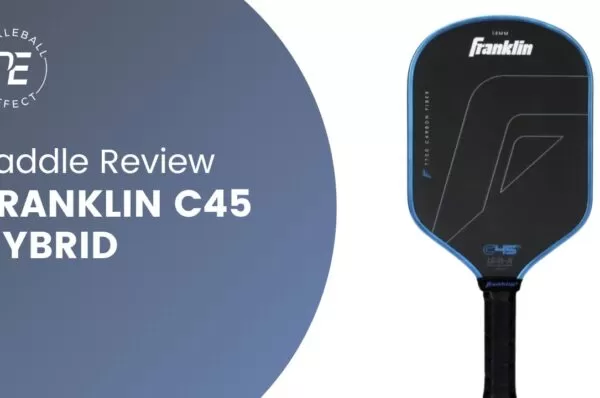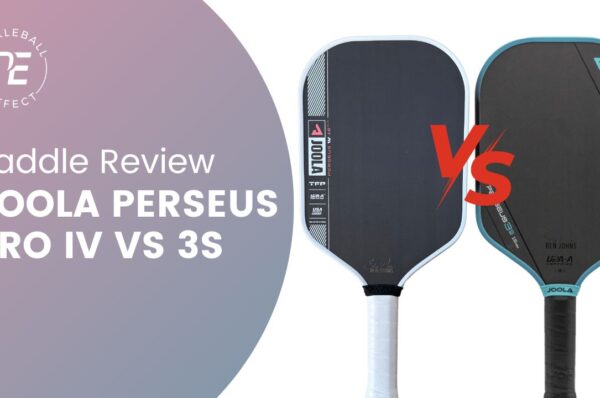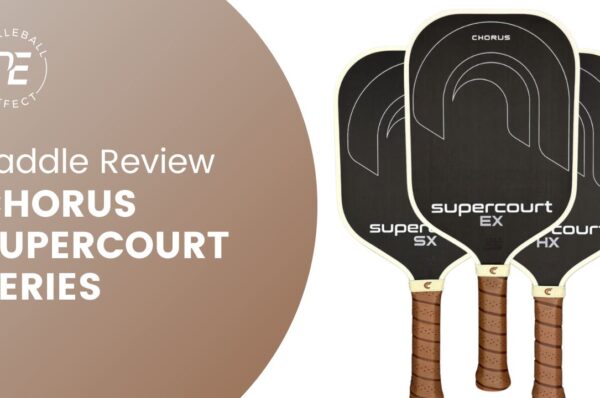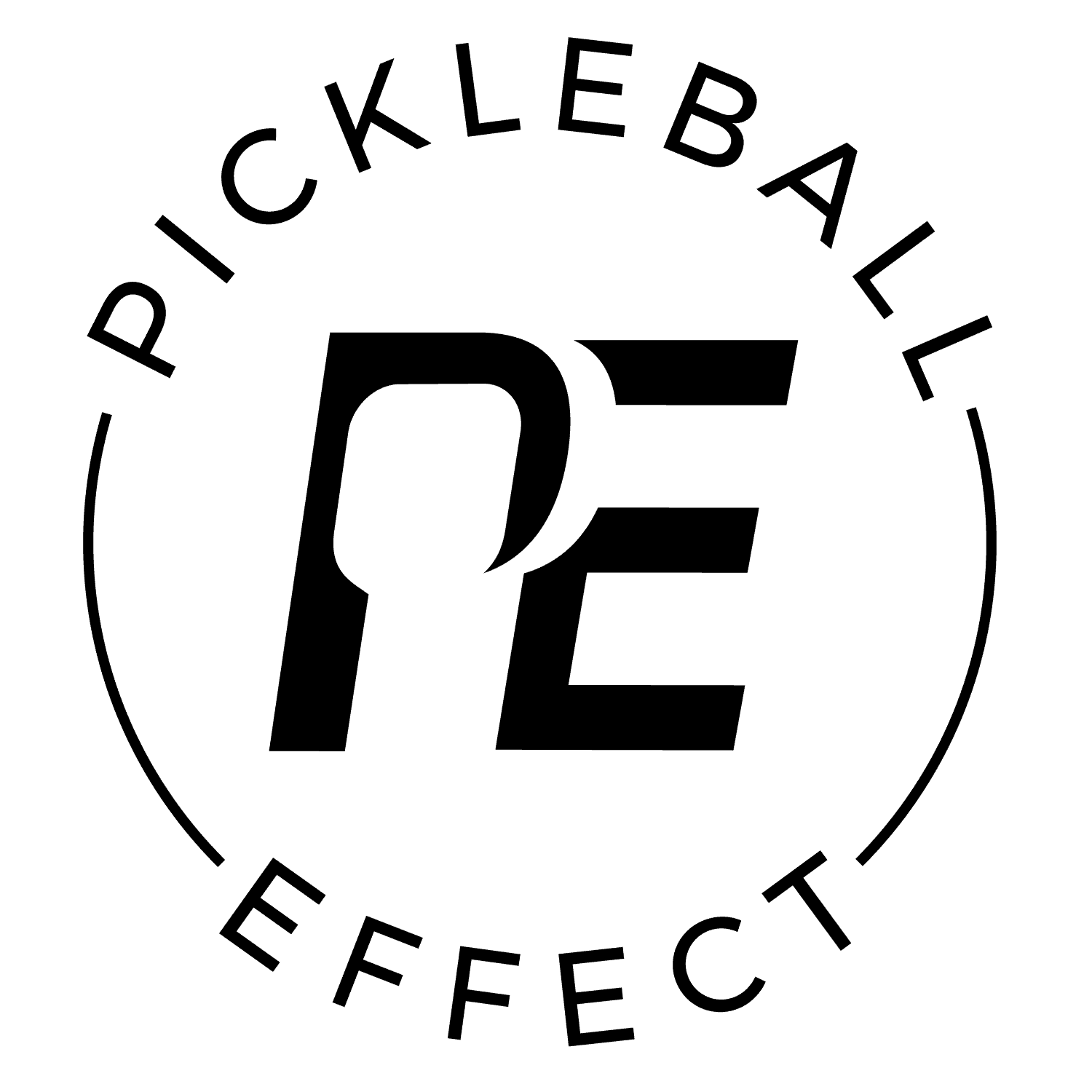Entering the market as a new paddle brand has become increasingly challenging. With the market maturing, established big brands and budget brands have solidified their positions. To succeed, new brands must differentiate themselves somehow. However, many new brands simply mimic popular paddles, which is not enough to stand out like it used to.
Thrive, a brand that emerged last year, found a way to stand out. While their initial paddle offerings were good, it’s not what caught my attention. They set themselves apart by offering the ability to select the exact swingweight when purchasing a paddle. This unique selling point is very cool and I’ll speak more about that below. And now, they just released their third paddle, the Azul 16, and its performance did catch my attention so let’s dive into the review.
After drilling and playing with the paddle for over two weeks, here’s my review on its performance.
Table of Contents
Paddle Stats & Tech
Thrive Azul 16
- Static Weight: 8.1-8.35
- Swingweight: 115-118 (moderate)
- Twistweight: 6.6-6.8 (high)
- Spin RPMs: 1948 (high)
- Length x Width: 16.3″ x 7.7″ (hybrid)
- Face: Carbon Fiber/Kevlar Weave
- Grip Circumference: 4.25″
- Handle Length: 5.5″
- Core: 16mm Polypropylene Honeycomb, Foam Walls
- Special Features: Thermoformed
- Paddle Type: Power
- Price: $199 ($180 with code 10EFFECT)
- Warranty: 120 days (four months)
(Get 10% off with the discount code 10EFFECT directly on Thrive’s website)
Performance Summary
Offense and Power
The Azul 16 falls into the power category and is the most powerful and poppy kevlar/carbon faced paddle I’ve played so far. It gives you some help on your serves and returns to keep them deep, puts a little extra heat on counters and makes it easier to finish points when presented with a high ball.
The paddle is a midweight paddle with a swingweight range between 115-118, so the power doesn’t come from a head heavy design. I love this about the paddle because you have the extra power but you still maintain maneuverability which goes a long way in fast hand exchanges at the net.
Although it sits in the power category, it’s not the most powerful paddle in the category which I think is a good thing for some players. This makes it more approachable and usable by a wider range of people. If you’re currently playing an all-court type paddle and are looking for a bump in power then this is a good option that will give that to you without overwhelming you. Having this lighter power profile also opens up some options when you’re looking for harder angles off of low balls. You can massage balls into spots with shots that are more difficult to execute with bigger power paddles like the Gearbox Pro Power paddles or the Engage Pursuit MX & EX.
Spin wise, my tests were averaging in the mid 1900 RPMs which puts it at the top with other great spin paddles and I never felt like I was missing spin in any scenario.
Forgiveness & Maneuverability
I mentioned above that the paddle is a midweight paddle though it still maintains a manageable swingweight. While so many power type paddles rely on extra weight for power, this one doesn’t and it pays off in the added maneuverability.
Then forgiveness wise, it felt very stable and strong there. This is another great thing going for this paddle. The paddle’s hybrid shape and 16mm core add stability and forgiveness to the paddle that so many power paddles are missing because they often rely on thinner cores to add power. I honestly don’t know why this paddle offers more power than others with similar designs, but whatever it is, it’s working.
Feel and Control
All other kevlar faced paddles I’ve played up until this point like the Six Zero Ruby or the Pickleball Apes paddles have a more muted, softer feel to them compared to the more responsive, connective feel of carbon fiber. However, the Azul doesn’t have that same muted feel as those other kevlar paddles. It has a stiffer feel in comparison. The paddle feels stiffer or firmer than 16mm carbon fiber paddles but does not feel as stiff and firm as fiberglass paddles like the Six Zero Black Diamond. It’s somewhere in the middle.
I didn’t think the feel of it was off putting or anything though I personally prefer a softer feeling so I did add some tungsten weighted tape to the paddle to soften it up a bit and I liked what that did for it. I walk through my weight set up in detail below.
On the control side, this is a more powerful and poppy paddle so you can expect a higher level of difficulty to keep the ball down in general though I found myself feeling confident with drops and working my way to the net after only a couple of sessions with it though volley dinks and out stretched dinks were tricker to keep down. For reference, I play with an all-court type paddle as my main paddle so this had a bit more pop and power than what I’m accustomed to. I do think this paddle is one of the easier power type paddles to control though you do need a developed soft game to control it well.
One final point worth mentioning is that when I do make a mistake with the paddle, it usually involves leaving the ball up a little rather than completely mishitting it. Many power paddles have narrower sweet spots, leading to two potential error-prone scenarios: pop-ups and mishits. However, with the Azul 16, the only concern was managing the soft game due to its forgiving nature. This is where the paddle holds a significant advantage over most power paddles, especially those with elongated designs.
My Tungsten Tape Set Up
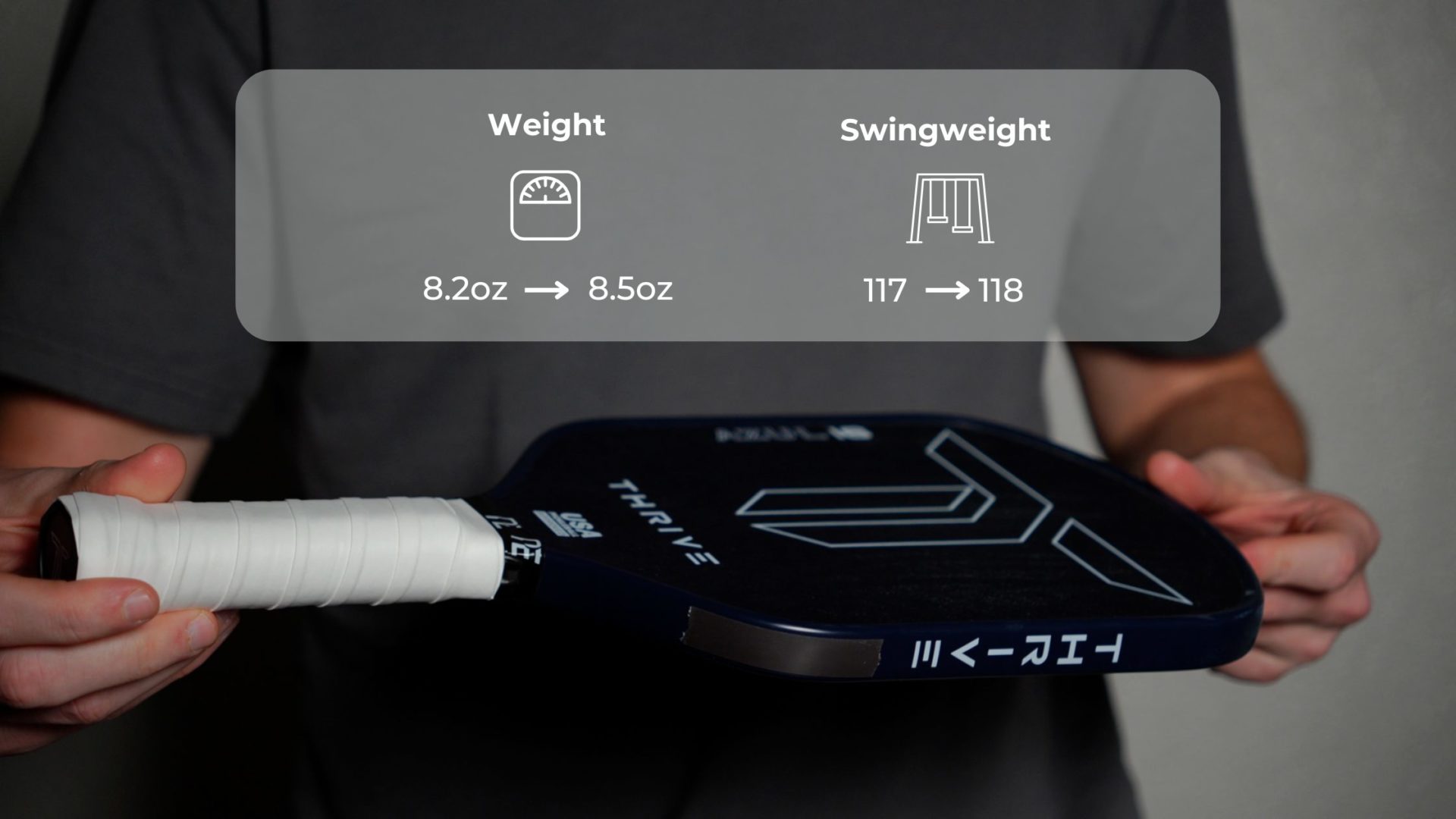
Because the paddle feels a bit stiffer out of the box, adding some weight helps soften it up a little and brings out a more familiar feel to it. This is why I decided to add some weight. I thought the paddle’s forgiveness and twistweight numbers were good so I didn’t feel a need to add weight to improve the paddles stability, just to improve the feel.
With that as my goal, I added 2 ½ grams of 1g per inch tungsten tape on the bottom corners of the paddle like this. With this set up I got the softer feel I wanted, added some stability as a by-product, and only increased the swingweight by 1 point. It started at 117 and bumped up to 118.
Then with my overgrip and weight on the paddle my final static weight was changed from 8.2oz to 8.5oz.
Selecting the Best Swingweight For You
The swingweight range the paddle has of 115-118 falls into the midweight category. As mentioned above, you can select the exact swingweight you want when you purcahse the paddle. 115 is more head light while 118 is more head heavy. 115 will feel lighter and be more maneuverable while 118 will be a little heavier and less maneuverable but will give you more plow through and power. If you’re not sure what to get, I would recommend 116. It’s a good middle ground and you can add weight if you’d like to without the swingweight getting away from you.
I love that they let you select which swingweight you want for two reasons.
- If you know your exact swingweight you like or just know you want a lighter or heavier paddle then you can get what you want and need.
- If you buy a second paddle, you can get the exact same swingweight you got before and know you’re getting a paddle that will perform the same as your first paddle.
One common frustration with other paddle brands is that they provide a weight range for their paddles, for example, 8 to 8.3 oz. However, when you purchase the paddle, you have no control over the specific weight you receive, leaving it up to chance. This inconsistency becomes even more annoying when you decide to purchase the same paddle again, as the weight of the second paddle may differ from your first, resulting in slight variations in performance and feel. This lack of consistency has always bugged me.
I genuinely hope that other brands take note and adopt a similar approach to what Thrive is doing. Allowing customers to specify the exact weight they want when purchasing a paddle not only mitigates the uncertainty but also ensures consistency across multiple purchases. This level of customization is something I believe players will greatly appreciate and is a step in the right direction for the industry.
My Recommendation
The Azul 16’s combination of good power & pop but not over the top power, good forgiveness, and manageable weight make it a more approachable and player-friendly power type paddle. Its only real drawbacks are that it has a stiffer feel that takes some getting used to and it comes in only one shape option. At least it’s a hybrid shape that is preferred and loved by a large portion of players.
If you’re looking for more power but don’t want to commit to a big power paddle like the Gearbox Power Pro series or the Engage Pursuit Pro series, then this is a good option. And if you are playing one of those bigger power paddles you might just like this one more because it has a good sized sweet spot and you’ll find yourself hitting less unforced errors.
(Get 10% off with the discount code 10EFFECT directly on Thrive’s website)
Braydon competes at the 5.0 level and plays in 5-10 tournaments a year. He plays/drills 3 to 4 times a week and would play more if time allowed it.

Paddle Terms Glossary
We’ve categorized paddles into three categories. Control, All-Court, and Power. Paddle categories are determined by Braydon after he hits or reviews the paddle.
- Control paddles offer a softer feel and better absorbs pace off the ball but doesn’t give you as much power.
- All-Court paddles give you a blend of power and control and does well at everything though it doesn’t excel at anything.
- Power paddles often have a firmer feel and will return more power but are harder to control.
A paddle’s weight represents the inherent mass of the paddle as measured on a scale. However, relying solely on this static weight measurement can be misleading when assessing the true perceived heaviness of the paddle. Even if two paddles both clock in at 8 oz, their actual heft in your hand can markedly differ due to variations in weight distribution within the paddle. This is why the static weight should be considered with the swingweight of the paddle. See the definition of swingweight below.
The weight value listed in the database corresponds to the paddle’s weight that I used to gather the swingweight and twistweight measurement. It’s possible that if your paddle has a different static weight than then the swingweight and twistweight may be slightly different.
There are three primary shapes a paddle can have which consists of the length and width of the paddle. These three shapes are:
- Elongated: The dimensions for an elongated paddle are 16.5″ x 7.5″.
- Standard: A standard shaped paddle has dimensions of 16″ x 8″.
- Hybrid: A hybrid shaped paddle falls somewhere in between the standard and elongated shapes, with approximate dimensions of 16.25″ x 7.5″-7.7″.
Then there are two less common shapes you’ll see. These are:
- Extra-Elongated: This shape is 17″ x 7″
- Widebody: This any paddle shorter than 16″ long.
When considering the advantages and trade-offs of paddle shapes, it’s important to understand the characteristics of each shape.
- Elongated Paddle: An elongated paddle offers increased reach, spin, and power. However, this additional reach comes at the expense of forgiveness, particularly from side-to-side.
- Standard Paddle: In contrast, a standard-shaped paddle provides less reach and a little less power & spin but offers greater overall forgiveness. This means that while you may not have the same extended reach as an elongated paddle, you gain better control and stability.
- Hybrid Paddle: The hybrid shape serves as a middle ground between the elongated and standard shapes. It provides a balance between reach and forgiveness, offering players a versatile option that combines aspects of both shapes.
It’s interesting to note that advanced players often prefer elongated shapes. On the other hand, players at lower skill levels typically opt for the extra forgiveness offered by standard shaped paddles.
Ultimately, the choice of paddle shape depends on an individual’s playing style, preferences, and skill level. Whether your focus is on reach or forgiveness, understanding the unique benefits and trade-offs of each shape can assist you in selecting the paddle that best suits your game.
Swingweight is a measure of the paddle’s resistance to swinging about the end of the handle. The higher the swingweight number the heavier it will feel in your hands. A higher swingweight has more power but is harder to swing, lower swingweight is easier to swing but has less power. Sometimes a faster swing with a lower swingweight can make up for power lost in swingweight. The price paid for that is greater impact shock. Stock swingweights will vary between 100 – 140.
Twistweight is the resistance to rotating around the long axis through the middle of the paddle from butt to tip. The higher the twistweight the more resistance the paddle has to rotating on off center hits. This measurement is closely related to the amount of forgiveness or the size of the sweet spot of the paddle. A higher twistweight indicates a bigger sweet spot. Twistweight numbers range from 5 – 8.
Measuring the revolutions per minute (RPMs) off of a serve you get a number that shows the spin potential of a paddle. Using these RPM measurements I’ve created five buckets that a paddle will fall into indicating its overall spin potential. The five buckets are:
1900 or Higher = Very High
1700 – 1900 = High
1500 – 1700 = Medium
1300 – 1500 = Low
1300 or less = Very Low
You can tell a big difference in the amount of spin a paddle generates when you compare a Very High paddle to a low paddle. But the gains from Medium to High to Very High are marginal. We’ve found that having at least a medium rating is often enough if you’re looking for a good spin paddle. However, if you’re a big hitter then you will benefit more from a high spin paddle to help you keep the ball in play more often.
The power level of a paddle is shown in miles per hour (MPH) after taking ten measurements with a speed gun of hitting a serve as hard as I can. This measurement gives you an idea of how hard you can hit the ball when given the chance to take a full swing. So shots like serves, drives and overheads. The higher the MPH reading the more power you can generate with the paddle.
I also show the percentile ranking of the measurement to give you an idea of how it stacks up against the rest of the paddles in my database.
The pop level of a paddle is shown in miles per hour (MPH) after taking the average of ten speed gun measurements of hitting a punch volley as hard as I can. This measurement gives you an idea of how hard you can hit the ball on shorter swings and gives you an idea of how quickly a ball comes off the face when you apply less force on the ball. So shots volleys, dinks, counters, and resets are all affected by the pop measurement. The higher the pop measurement the stronger your counters will be but it takes more skill to keep the ball from floating or popping up on you when resetting a hard hit ball or when dinking.
I also show the percentile ranking of the measurement to give you an idea of how it stacks up against the rest of the paddles in my database.
